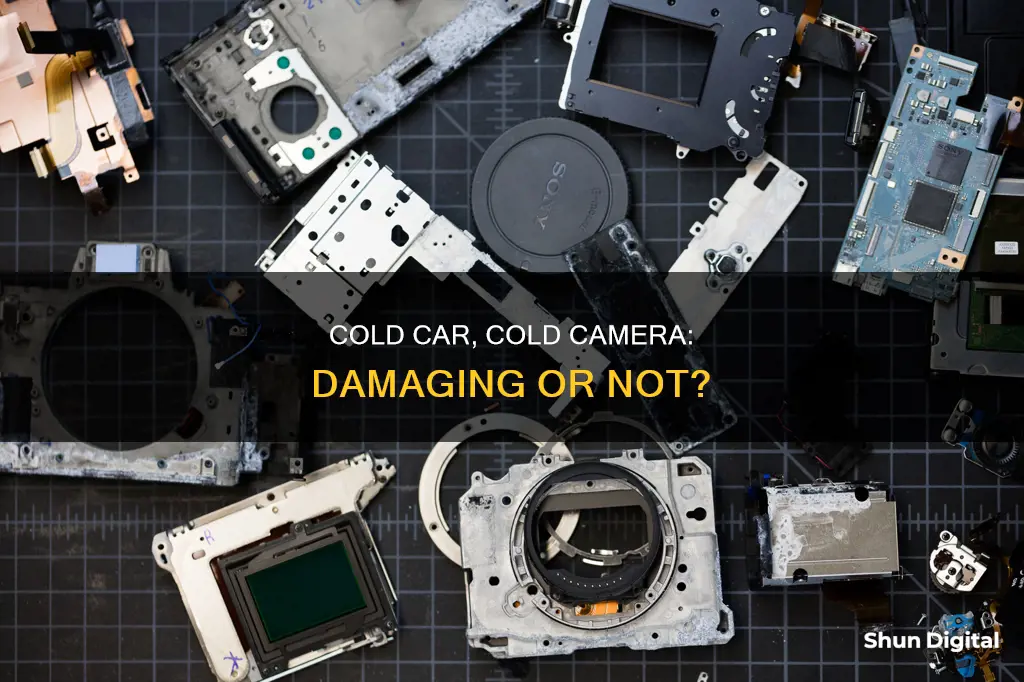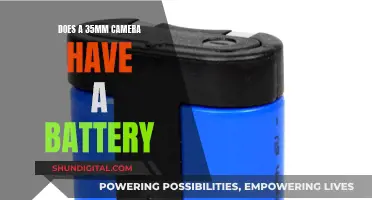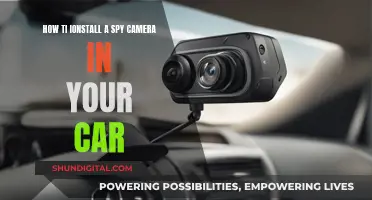
Leaving a camera in a cold car can be problematic for several reasons. Firstly, there is a risk of theft, as a camera left in a car is an easy target for thieves. Secondly, the cold temperature can drain the camera's battery very quickly, and frequent temperature fluctuations may also negatively impact the battery's long-term performance. Additionally, condensation can form on the camera and lens when brought back into a warmer environment, which can be managed by placing the camera in a sealed plastic bag.
| Characteristics | Values |
|---|---|
| Camera damage | Unlikely |
| Battery life | Drained quickly |
| Condensation | Likely |
| Theft | Likely |
What You'll Learn
- Cold temperatures may drain the camera's battery
- Condensation can occur when moving the camera from cold to warm environments
- Extreme temperature fluctuations may damage the camera's battery
- The camera is at risk of being stolen if left in the car
- Keeping the camera in a bag or sealed plastic bag can help prevent condensation

Cold temperatures may drain the camera's battery
To mitigate the impact of cold temperatures on your camera's battery, you can take several precautions. One option is to remove the battery from the camera and keep it in a warm place, such as inside your coat pocket, while the camera is in the cold car. This way, the battery stays warm and can provide more charge when needed. Another option is to carry spare batteries with you and swap them out when the camera's battery starts to drain. Keeping spare batteries warm inside your coat can help revive them once they have warmed up.
It is worth noting that while cold temperatures can affect battery life, they may not cause permanent damage. Some photographers have reported that their batteries have survived multiple nights of freezing temperatures without any issues. Additionally, cold temperatures can even be beneficial for long-term battery storage as they reduce degradation.
To summarise, cold temperatures can drain your camera's battery, but you can take steps to mitigate this, such as keeping batteries warm and carrying spares. While the cold may reduce battery life, it may not cause permanent damage, and it can even be beneficial for long-term storage.
Gateway Notebook: Accessing the Camera with Ease
You may want to see also

Condensation can occur when moving the camera from cold to warm environments
- Place the camera in a sealed plastic bag when bringing it indoors. This helps to regulate the temperature change and prevents moisture from forming on the camera.
- Keep the camera in a closed bag, even a plastic bag, to slow down the warming process when you enter a warm environment.
- Use a small hard plastic thermal cooler to store your camera. This not only helps to temper extreme temperature changes but also serves as a disguise, making it less attractive to potential thieves.
- Allow your camera to warm up gradually by keeping it in the closed car with the heater on while you drive.
- If possible, avoid drastic temperature changes by keeping your camera in a cold environment, such as a car trunk, until it has reached a similar temperature. Then, bring it into the warmer environment.
- When going from a cold to a warm environment, turn off your camera and other electronic devices to prevent condensation. Wait for them to warm up gradually before turning them back on.
By following these precautions, you can help prevent condensation and potential damage to your camera when moving between cold and warm environments.
Oklahoma's Camera-Based Speeding Ticket System: How It Works
You may want to see also

Extreme temperature fluctuations may damage the camera's battery
Extreme temperature fluctuations can indeed damage a camera's battery. The cold itself is unlikely to damage the camera, but it will drain the battery very quickly. The same is true of the heat. Extreme cold is very hard on batteries, and frequent temperature fluctuations might be damaging.
If you are going to leave your camera in the car, it's a good idea to take the battery out and keep it with you. Keeping the camera in a sealed plastic bag can help to prevent condensation, but you should still be careful of condensation when bringing the camera inside.
If you're going to be shooting in the cold, it's a good idea to bring a few spare batteries and keep them warm inside your coat. When one dies, you can swap it out with a warm one.
Easy Guide to Mounting Your PoE Surveillance Camera
You may want to see also

The camera is at risk of being stolen if left in the car
Leaving a camera in the car is a bad idea, as it is practically begging for it to be stolen. Even if you live in a safe area, it is still at risk of being taken. If your car is broken into, a thief may take the camera along with other items, even if the camera was not what attracted them in the first place.
The size and shape of your camera, as well as where and how it is placed in your car, can affect how visible it is and how easily it can be taken. A larger camera is likely to be more visible than a small, compact one. If your camera is easily detachable from its mount, it may be worth taking it with you when you leave the car.
If you decide to leave your camera in the car, there are a few things you can do to reduce the risk of theft. Hiding the camera cords can make it less obvious that you have a camera in the car, and thus less of a target for thieves. You can also invest in a dash cam with motion-sensing and parking mode features, which can record incidents even when your car is turned off and provide video evidence in the event of a break-in.
Additionally, consider getting insurance for your camera equipment to protect yourself financially in case of theft or damage.
Charging Your Fujifilm Waterproof Camera: A Step-by-Step Guide
You may want to see also

Keeping the camera in a bag or sealed plastic bag can help prevent condensation
Keeping your camera in a bag or sealed plastic bag is a good idea for several reasons. Firstly, it helps to regulate the temperature of your camera, preventing it from warming up too quickly when you turn on the heat in your car or when you bring it inside. This is important because rapid temperature changes can cause condensation, which can damage your camera. By slowing the warming process, you give moisture a chance to evaporate, reducing the risk of condensation.
Secondly, a bag can provide a layer of protection against theft. While it's not foolproof, a camera bag is less likely to attract the attention of thieves than a camera left out in the open. It's also a good idea to keep your camera out of direct sunlight, as this can get very hot and damage your equipment.
Additionally, a bag can help to protect your camera from physical damage, such as scratches or dents, that could occur if the camera is left loose in your car.
Finally, a sealed plastic bag can help to keep your camera and lenses free of dust and other particles that may be floating around in the air. This is especially important if you're driving with the windows down or in an area with high winds.
Battery Life of Wireless Security Cameras: How Long?
You may want to see also
Frequently asked questions
It depends on the temperature. Extreme cold is very hard on batteries, so you may want to take the battery out and keep it with you. However, condensation can also be a problem when bringing your camera inside, so it's best to keep your camera in a sealed plastic bag.
It's best not to leave your camera in a hot car. One photographer left their telephoto lens wrapped up in the trunk of their car for an hour when the temperature was in the 80s, and this was hot enough to melt the lubricants for the aperture blades in their lens.
Even in moderate temperatures, it's not recommended to leave your camera in your car due to the risk of theft.
If you have to leave your camera in the car, keep it in a camera bag so it doesn't warm up too fast when you turn on the heat. You can also put it in a small hard plastic thermal cooler, which will keep temperature changes moderate and make it less obvious to thieves.







